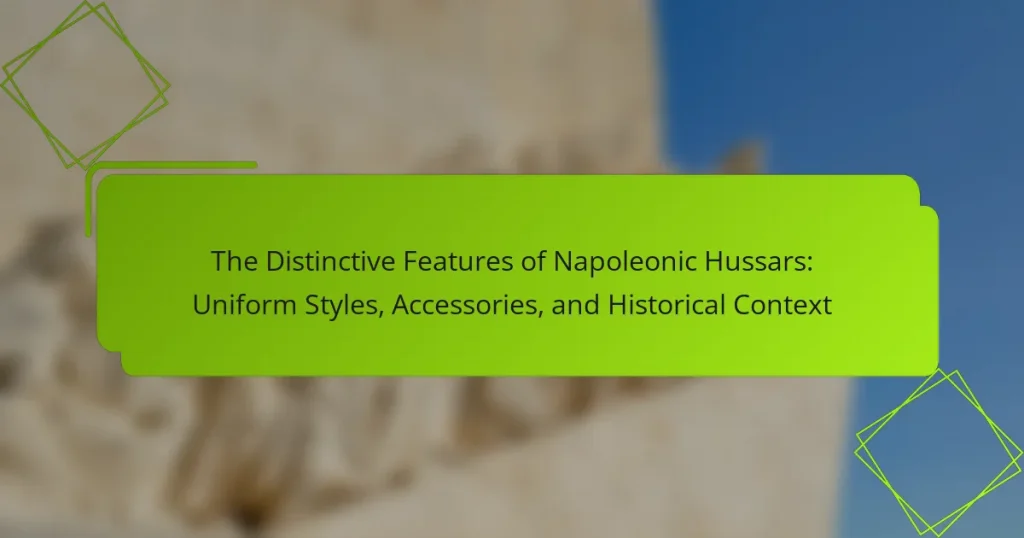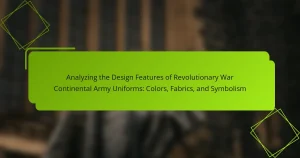Napoleonic Hussars are a notable type of light cavalry recognized for their vibrant uniforms, tactical mobility, and unique headgear. Their attire typically includes a pelisse, a short fur-lined coat, and distinctive headgear such as a busby or shako, embellished with plumes. These cavalry units were instrumental in reconnaissance and skirmishing during the Napoleonic Wars, demonstrating remarkable speed and effectiveness in various campaigns. The article explores the distinctive features of Napoleonic Hussars, including their uniform styles, accessories, and the historical context that shaped their legacy, which continues to influence modern military fashion and cavalry units.

What are the Distinctive Features of Napoleonic Hussars?
Napoleonic Hussars are characterized by their flamboyant uniforms, light cavalry tactics, and distinctive headgear. Their uniforms often featured bright colors, intricate braiding, and unique cut styles. Hussars typically wore a pelisse, which was a short, fur-lined coat, worn over one shoulder. The headgear included a busby or a shako, adorned with plumes or cords. They were known for their mobility and speed on the battlefield. Hussars played crucial roles in reconnaissance and skirmishing during the Napoleonic Wars. Their legacy includes influencing modern cavalry units and military fashion. Historical records highlight their bravery and effectiveness in various campaigns.
How did the uniform styles of Napoleonic Hussars evolve over time?
The uniform styles of Napoleonic Hussars evolved significantly throughout the Napoleonic Wars. Initially, Hussar uniforms were influenced by Hungarian styles, featuring colorful, often elaborate designs. By the early 1800s, the French Hussars adopted more standardized military uniforms. These included the distinctive pelisse, a short, fur-lined coat worn over one shoulder.
As the wars progressed, the colors and embellishments became more regimented. The use of specific colors represented different regiments, creating a sense of identity. The introduction of the shako, a tall military hat, replaced earlier headgear like the busby.
By the end of the Napoleonic era, Hussar uniforms showcased a blend of practicality and flamboyance. They maintained their colorful appearance while adapting to the needs of modern warfare. This evolution reflected both the changing nature of military engagements and the desire for soldiers to stand out on the battlefield.
What were the key elements of the early Napoleonic Hussar uniforms?
The key elements of early Napoleonic Hussar uniforms included a distinctive cut, vibrant colors, and unique accessories. The uniform typically featured a short, tailored jacket known as a dolman. This jacket was often adorned with intricate braiding and embellishments. Hussars wore a pelisse, a fur-lined overcoat, draped over one shoulder. The trousers were usually tight-fitting and often made of bright fabric. Headgear included a busby or a shako, often decorated with plumes. The use of sashes and belts added to the uniform’s visual appeal. These elements combined to create a striking and recognizable appearance on the battlefield.
How did the colors and patterns of Hussar uniforms signify different regiments?
The colors and patterns of Hussar uniforms indicated the specific regiments to which soldiers belonged. Each regiment had a unique combination of colors that distinguished it from others. For example, the 7th Hussars wore a distinctive blue and yellow uniform. The 15th Hussars, on the other hand, sported a red and blue combination. Patterns such as stripes, sashes, and lace also varied by regiment. These visual elements helped in quick identification during battles. Additionally, the use of specific insignia further clarified the regiment’s identity. This system of colors and patterns was crucial for maintaining order and organization in the cavalry.
What accessories were commonly associated with Napoleonic Hussars?
Napoleonic Hussars were commonly associated with several distinctive accessories. These included fur pelisses, which were worn over the uniform for warmth and style. Hussars also sported shako hats, often adorned with colorful plumes or cords. Sashes were a significant accessory, typically worn around the waist, adding a touch of flair to their appearance. They carried sabers as their primary weapon, showcasing their cavalry role. Hussars often had leather boots that were knee-high, suitable for mounted combat. Additionally, they sometimes wore epaulettes, which indicated rank and added to their visual appeal. These accessories contributed to the hussars’ reputation for flamboyance and boldness on the battlefield.
What role did the shako play in the Hussar uniform?
The shako served as a key component of the Hussar uniform. It was a tall, cylindrical military hat worn by Hussars during the Napoleonic era. The shako provided both protection and a distinctive silhouette. Its design often featured decorative elements such as cords, plumes, and insignia. These embellishments enhanced the visual appeal of the uniform. The shako also signified rank and unit affiliation. It contributed to the overall identity and cohesion of Hussar regiments. Historical records indicate that the shako became a symbol of the light cavalry’s mobility and style.
How did sabers and other weaponry complement the Hussar’s appearance?
Sabers and other weaponry significantly enhanced the Hussar’s appearance by adding a sense of elegance and intimidation. The curved saber, known for its distinctive shape, was often worn at the hip, accentuating the Hussar’s silhouette. This positioning allowed for quick access during combat, demonstrating both readiness and style.
Additionally, the flamboyant design of the sabers, often adorned with intricate hilts, complemented the colorful uniforms of the Hussars. Other weaponry, such as pistols and lances, further contributed to their striking appearance. The combination of these weapons created a dynamic visual impact, reinforcing the Hussar’s reputation as elite cavalry.
Historically, the Hussars were known for their flamboyant attire, and their weaponry played a crucial role in this aesthetic. The overall effect was one of both functionality and flamboyance, making the Hussars a memorable presence on the battlefield.
What historical context influenced the development of Hussar uniforms?
Hussar uniforms developed primarily during the 15th and 16th centuries in Eastern Europe. The influence of the Ottoman Empire was significant, as they introduced light cavalry tactics. These tactics emphasized speed and mobility, which shaped the design of Hussar uniforms. The uniforms featured distinctive elements like colorful sashes and fur-trimmed coats.
During the 18th century, European armies adopted Hussar styles, influenced by their success in battle. The French Revolution further popularized these uniforms, as they became symbols of prestige. The Napoleonic Wars saw Hussars playing crucial roles, leading to variations in uniform styles across nations.
Overall, the historical context of warfare, cultural exchanges, and military reforms significantly influenced the development of Hussar uniforms.
How did the Napoleonic Wars shape the identity of Hussars?
The Napoleonic Wars significantly shaped the identity of Hussars by solidifying their role as elite light cavalry. During this period, Hussars became known for their distinctive uniforms, which included colorful jackets and intricate decorations. These uniforms were designed to enhance their visibility on the battlefield and symbolize their status.
The wars also emphasized their tactical importance in reconnaissance and skirmishing. Hussars were often deployed for rapid maneuvers and intelligence gathering, showcasing their agility and speed. This operational focus further distinguished them from other cavalry units.
Additionally, the Napoleonic Wars fostered a sense of camaraderie and pride among Hussars. They participated in key battles, such as the Battle of Austerlitz, which contributed to their legendary status. This legacy continues to influence the perception of Hussars in military history.
What cultural influences can be seen in Hussar attire and accessories?
Hussar attire and accessories reflect a blend of Eastern European, Ottoman, and Western European influences. The vibrant colors and elaborate designs are rooted in the Hungarian and Polish military traditions. The use of fur and intricate embroidery showcases the Ottoman impact on Hussar uniforms. Additionally, the adoption of the pelisse, a type of coat, highlights Western European fashion trends of the time. The distinctive headgear, such as the busby, draws from various cultural inspirations. Overall, Hussar attire exemplifies a rich tapestry of cultural exchanges across Europe and beyond.
How do the distinctive features of Napoleonic Hussars compare to other cavalry units?
Napoleonic Hussars are distinguished by their unique uniforms, light cavalry tactics, and roles as skirmishers. Their uniforms featured colorful jackets, fur pelisses, and distinctive headgear, setting them apart visually from other cavalry units. In contrast, heavier cavalry units, such as cuirassiers, wore more protective armor and less flamboyant attire. Hussars were primarily used for reconnaissance and rapid maneuvers, while other cavalry types often engaged in direct combat. Historically, Hussars originated from Eastern European light cavalry, evolving into elite units under Napoleon. Their agility and speed were crucial during the Napoleonic Wars, demonstrating their effectiveness in various battlefield scenarios.
What unique attributes set Hussars apart from dragoons or lancers?
Hussars are distinguished by their light cavalry role, unique uniforms, and specific tactical functions. Their uniforms often feature distinctive pelisses, fur hats, and elaborate decorations. In contrast, dragoons typically wear standard military attire and serve as mounted infantry. Lancers are characterized by their use of lances and specific lance-carrying tactics. Hussars were known for their speed and mobility on the battlefield. They often engaged in reconnaissance and skirmishing, unlike dragoons and lancers who had different combat roles. Historical records indicate that Hussars originated in Hungary in the 15th century, emphasizing their unique cultural roots. This historical context further sets them apart from dragoons and lancers, who evolved from different military traditions.
How did the role of Hussars differ from other cavalry in battle strategies?
Hussars served a unique role in battle strategies compared to other cavalry units. They were primarily used for reconnaissance and skirmishing. This specialization allowed them to gather intelligence on enemy positions. Hussars often engaged in hit-and-run tactics, exploiting their speed and agility. Unlike heavier cavalry, they did not focus on frontal assaults. Their lighter armor facilitated mobility and quick maneuvers. Historical records show that Hussars were effective in disrupting enemy formations. They played a crucial role in the Napoleonic Wars, showcasing their distinctive operational strategies.
What are the lasting impacts of Napoleonic Hussars on modern military uniforms?
Napoleonic Hussars significantly influenced modern military uniforms through their distinctive styles and design elements. The use of bright colors and intricate embellishments became a hallmark of military attire. Hussars introduced the use of braided cords and decorative sashes, which are still seen in various military uniforms today. Their unique headgear, such as the busby and pelisse, inspired modern ceremonial hats and outerwear. The emphasis on mobility and flair in Hussar uniforms helped shape the concept of dress uniforms in contemporary armies. Additionally, the practice of incorporating historical styles into modern uniforms reflects the Hussars’ lasting legacy. The blending of functionality and aesthetics in military attire can be traced back to their influence.
How can the legacy of Hussar style be seen in contemporary military fashion?
The legacy of Hussar style is evident in contemporary military fashion through the incorporation of vibrant colors and intricate detailing. Modern military uniforms often feature similar bold color schemes, reflecting the Hussars’ flamboyant aesthetic. Additionally, the use of decorative elements such as braiding and epaulettes can be traced back to Hussar uniforms. These embellishments enhance the visual appeal of contemporary attire. The influence extends to headgear, as modern military caps sometimes resemble the distinctive busbies worn by Hussars. Overall, the Hussar style has left a lasting mark on military fashion, emphasizing both functionality and visual impact.
What lessons can modern military units learn from the Hussar tradition?
Modern military units can learn the importance of mobility and adaptability from the Hussar tradition. Hussars were known for their rapid maneuvers and ability to operate effectively in diverse terrains. Their emphasis on speed allowed them to execute reconnaissance and flanking operations successfully. Additionally, the Hussar tradition highlighted the value of distinctive uniforms to foster unit identity and morale. This tradition can inspire modern units to develop unique branding that enhances cohesion. Furthermore, Hussars often employed innovative tactics that can inform contemporary military strategies. Their approach to cavalry operations emphasizes the need for flexibility in modern combat scenarios. Historical records show that Hussars played crucial roles in pivotal battles, demonstrating the effectiveness of their tactics.
What practical tips can enthusiasts follow to understand Napoleonic Hussars better?
Enthusiasts can better understand Napoleonic Hussars by studying their uniforms and historical roles. Research specific regiments to learn about their unique styles and colors. Analyze primary sources, such as paintings and military records, to gain insights into their appearance and tactics. Attend reenactments or historical events to observe their portrayal in action. Engage with online forums or communities dedicated to Napoleonic history for discussions and resources. Read scholarly articles that focus on the evolution of Hussar tactics and their impact on warfare. Familiarize yourself with the social and political context of the Napoleonic Wars to appreciate their significance. Utilize visual aids, such as diagrams or timelines, to grasp the chronology and development of Hussar units.
The main entity of the article is Napoleonic Hussars, a light cavalry unit known for their distinctive uniforms and tactical roles during the Napoleonic Wars. The article outlines the key features of Hussar uniforms, including their vibrant colors, unique accessories, and the evolution of styles over time. It also discusses the historical context that influenced these uniforms, the significance of their accessories, and the role of Hussars in battle strategies. Additionally, the article highlights the lasting impacts of Hussar style on modern military fashion and offers practical tips for enthusiasts to deepen their understanding of this unique cavalry unit.




